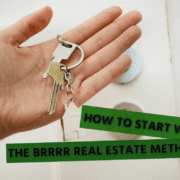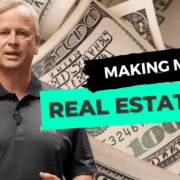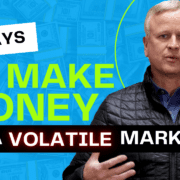You’re here to make money. How do you make money real estate investing in 2022?
The real estate market has changed. The economy has changed. The money side of flipping has changed. If you’re a newer real estate investor, you might be feeling hesitant right now.
We’ve been through over twenty years of markets. We’ve seen many markets that look similar to ours in 2022.
Take our word for it: here’s what will make you money this year in your real estate investment career.
4 Real Estate Basics That Can Make You Money in 2022
The best real estate investments are the evergreen basics. Here are 4 consistent ways of creating cashflow — if you do it right based on your market.
1) Flips
Buying, fixing, and then selling properties is a common investment strategy. But to make money on fix-and-flips in 2022, you’ll have to focus carefully on the numbers. Flips make money in one lump sum, not in a steady cash flow over time. So in tougher markets, it’s important to make that large sum count.
This year especially, we recommend staying in the medium to lower price range for your flips. We’re still seeing people selling well in the medium price range. Larger properties, however, are feeling a lot of pressure in this market.
For flips, focus on the numbers and stick to medium price ranges. (More on this later in the article).
2) BRRRR
Buying and fixing up rental properties is another of the best real estate investments. But BRRRR is taking a bit of a hit right now due to interest rates. Interest rates have more than doubled since the beginning of 2022, which will seriously impact your cash flow.
You can still make money from BRRRR properties this year, but you’ll have to be extra careful with numbers. Know your credit score, know your interest rates, and know the rent prices for your area.
3) Subject Tos
A “subject to” is when you buy someone’s property, take over their mortgage, and make all payments, but you don’t assume the loan. The property is in your name and you have ownership, but it stays financed by the seller.
Subject tos will be great opportunities in 2022. You can walk into a property where the rate on the mortgage is still 2.5% – 3%, potentially with renters in place. This will bring a much higher cash flow than if you started from scratch on the open market, where interest rates are almost double that.
Using subject tos is a great way to grow a big portfolio using someone else’s financing. (You’ll see more about subject tos in 2022 later in the article).
4) Notes
Another great tactic for real estate investors this year is to use your money in deeds of trust or other private lending.
Rates have gone up, but banks still haven’t really raised CD rates. If you have some money sitting in an account, notes are a good way to get a higher return. You can lend to other investors through gap funding or a more long-term agreement. Notes are becoming big in real estate again, especially with the market in 2022.
Passive Ways to Make Money in Real Estate in 2022
Maybe you feel like you want to use 2022 as an opportunity to tap out of the active flipping game. But, you also don’t want to lose the chance for real estate cash flow. We’ve got three good passive real estate investing options for you.
1) Subject Tos with Rentals
Subject to rentals will be a pretty safe bet for passive real estate income this year. With a subject to, the loan is still under the original financier’s name. You’re just making payments, so the mortgage won’t cloud up your credit.
It’s relatively easy to add 5 – 10 properties to your rental portfolio without adding more debt to your name. If you put these rentals in with a property management company, you can still make a good amount of passive cash flow.
2) Private Notes
Deeds of trust or private lending is a reliable, secured, passive way to put money to work in real estate. With notes, you lend your money to friends or other people in the markets who are looking for funding – and you don’t have to worry about doing any of the work on the property.
Instead of making 1-2% with a bank’s CD rate, you could double or triple that by lending privately. We’ve helped thousands of people successfully lend this way, so contact us for more information.
3) REITs (Real Estate Investment Trusts)
Real Estate Investment Trusts work a bit like a mutual fund. You pool your money with a bunch of other people, and the company uses that money to buy real estate. You’re just one of many investors, and everyone earns a return on the properties.
There are public REITs and private REITs. With public, you can trade on the open market. With private, you have a little more restriction; once you get in, you stay in.
REITs are a great option if you want to invest in real estate but want someone else to manage it. If you’re looking for passive real estate income, research REITs in your area.
Commercial Real Estate Investing in 2022
2022 may be the year you want to venture into commercial real estate. Apartments buildings with over five units, retail space, office buildings, and industrial areas all fall under commercial real estate.
How do you invest in commercial real estate?
One option for commercial real estate investing is to hold or flip just as you would any single-family home. We’ve also seen a lot of people find success with another option recently: buying bigger industrial properties, flipping them, and splitting them up into separate properties to sell.
Cap Rates in Commercial Real Estate
An important number to consider in commercial real estate is the cap rate. All commercial properties come with a cap rate, which is the return you can expect on your investment.
For example, if you put $100,000 into a property with a 4% cap rate, you can expect a return of $4,000; this is probably an area that pays lower rent. But a $100,000 investment on an 8% cap rate will have an $8,000 return, so the property will have higher cash flow.
Generally, the higher the cap rate, the lower the value because it may be considered a riskier investment. The lower the cap rate, the higher the value because more people are more willing to put more money in.
People take lower cap rates over higher ones because they believe a lower cap rate market is more stable. It’s like when you put money into a CD – the appeal is the stability, despite the lower rate. People who look for higher cap rates prioritize return over long-term growth or stability.
Cap rates differ city-to-city and within cities. If you’re interested in commercial properties, you can talk to a commercial broker in your area to understand local cap rates.
Two Biggest Opportunities for Real Estate Investing in 2022: Fix-and-Flips and Subject Tos
How you’ll choose to make money in 2022 will depend on you, your market, and your current financial situation.
But we expect that the two best real estate investment methods this year will be flipping and subject tos. Here’s how you can make money using these investment strategies:
How to Flip for Profit
At the beginning of 2022, flipped homes would sell in a matter of hours, rather than weeks or months. The fix-and-flip experience will be a little different in the remainder of 2022. But flipping is still a great opportunity to make a profit in real estate.
What Properties Will Flip for Profit?
Your best bet for income in real estate flipping will be sticking to medium price point properties.
Some areas – for example, City center of Denver — are still doing great in higher price ranges. People are still selling $1 – 2 million dollar properties with no issues. But in smaller communities, there are fewer people who can afford $600,000 – $900,000 properties.
With rising interest rates, people who were looking in those higher price ranges now need to look a little lower. Medium property prices are also always competing with rent.
Even though interest rates have gone up 5 – 6%, a $150,000 – $250,000 house will still be in a competitive market with rent. As long as they can afford it, people will always steer toward buying a home rather than renting.
Rent prices aren’t going anywhere but up. We may see changes in the renting sphere as congress discusses hedge funds and other big investors driving rent prices up. But for you now, rising rents could push more people to consider home ownership in the low-to-mid price range.
Flipping Expectations for 2022
When you look at your market, know that 3-bedroom, 2-bath, and garage homes will always be reliable as a seller. People will always be searching for those types of properties for their families.
You’ll find buyers in this range, but be sure to adjust your expectations. In the last market, buyers would make offers within hours or days. The reality of this upcoming market is it might take one or two months to find a buyer. Be patient, take your time, look at your area, and keep an eye out for upcoming foreclosures and other opportunities.
Subject To Real Estate Investing
A “subject to” is when you buy someone’s property subject to them leaving the mortgage on the property. You become the owner, you receive the deed or title, and you take over the loan. But it’s still the same loan, in the original owner’s name. You’re not assuming, or refinancing. They keep the loan on the property, and you just make the payments.
Should You Do a Subject To?
How is a subject to beneficial for you? The property’s existing mortgage will likely have rates close to 2.5-3% – rather than the 6% rate you’d get on a new loan. Also, in a subject to, you assume no additional debt.
Most subject tos are made for rentals, lease options, or contract for deeds. A subject to property is not a great place to flip. When people are willing to do a subject to, the reason they’re not selling the property is they can’t get the price that they want at the speed they want. So they have to get rid of the property this way to avoid wrecking their credit for future loans.
The Money Side of Subject Tos
We’ve seen clients with 50 – 200 subject to properties. Subject tos are a great way to build a portfolio without using your credit, and without maxing out your loan opportunities with lenders.
Sometimes with subject tos, you’ll have to give the owner of the mortgage some money to give over the property. There are also occasional fix-up costs, depending on the condition of the property.
Why some people don’t want to jump into a subject to is because they don’t have the $5,000 – $15,000 start-up costs to get into it. We recommend looking into OPM as a way to cover these costs and take advantage of subject tos.
You’re getting the cheapest possible financing on a property, so it doesn’t matter much if the loan is still at 100%. Making monthly payments continually brings the loan down. And you’re free from many other financing and closing costs.
If you get a long-term renter, or someone who wants to do a lease option and put some money down, subject tos can become a great source of cash flow.
Subject tos are going to be hot as foreclosures pick up, selling times slow, and people can’t afford to fix up their properties. They are one of the best ways to take advantage of a down market and build a large real estate portfolio.
What To Do Next?
The real estate market at the end of 2022 will look very different than it did in the beginning. But there are always options for making money in real estate – in any market.
We have plenty of experience in markets like the one we’re now entering. If you need more guidance as you navigate your real estate investment career this year, let us help.
Download our free real estate investment resources here.
Check out the information on our YouTube channel here.
And always feel free to reach out to us at hardmoneymike.com.
Happy Investing.










